towing LINCOLN MKS 2016 Owners Manual
[x] Cancel search | Manufacturer: LINCOLN, Model Year: 2016, Model line: MKS, Model: LINCOLN MKS 2016Pages: 382, PDF Size: 3.81 MB
Page 6 of 382
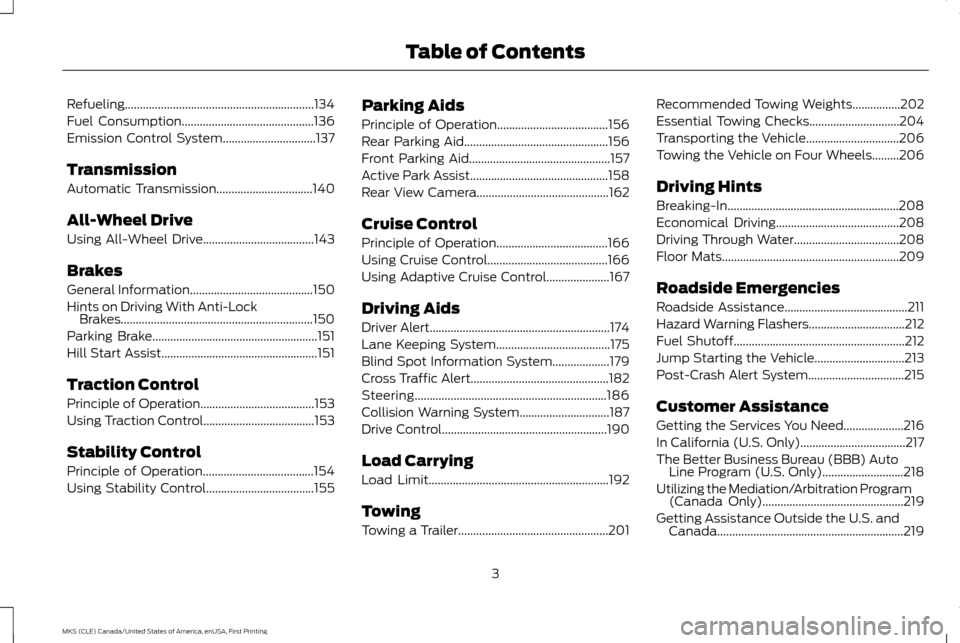
Refueling...............................................................134
Fuel Consumption............................................136
Emission Control System...............................137
Transmission
Automatic Transmission
................................140
All-Wheel Drive
Using All-Wheel Drive.....................................143
Brakes
General Information
.........................................150
Hints on Driving With Anti-Lock Brakes................................................................150
Parking Brake
.......................................................151
Hill Start Assist
....................................................151
Traction Control
Principle of Operation......................................153
Using Traction Control
.....................................153
Stability Control
Principle of Operation.....................................154
Using Stability Control....................................155 Parking Aids
Principle of Operation.....................................156
Rear Parking Aid................................................156
Front Parking Aid
...............................................157
Active Park Assist..............................................158
Rear View Camera
............................................162
Cruise Control
Principle of Operation
.....................................166
Using Cruise Control........................................166
Using Adaptive Cruise Control.....................167
Driving Aids
Driver Alert
............................................................174
Lane Keeping System......................................175
Blind Spot Information System
...................179
Cross Traffic Alert..............................................182
Steering................................................................186
Collision Warning System..............................187
Drive Control
.......................................................190
Load Carrying
Load Limit............................................................192
Towing
Towing a Trailer
..................................................201 Recommended Towing Weights................202
Essential Towing Checks..............................204
Transporting the Vehicle...............................206
Towing the Vehicle on Four Wheels.........206
Driving Hints
Breaking-In.........................................................208
Economical Driving
.........................................208
Driving Through Water...................................208
Floor Mats
...........................................................209
Roadside Emergencies
Roadside Assistance
.........................................211
Hazard Warning Flashers................................212
Fuel Shutoff
.........................................................212
Jump Starting the Vehicle..............................213
Post-Crash Alert System................................215
Customer Assistance
Getting the Services You Need....................216
In California (U.S. Only)...................................217
The Better Business Bureau (BBB) Auto Line Program (U.S. Only)...........................218
Utilizing the Mediation/Arbitration Program (Canada Only)
...............................................219
Getting Assistance Outside the U.S. and Canada..............................................................219
3
MKS (CLE) Canada/United States of America, enUSA, First Printing Table of Contents
Page 96 of 382
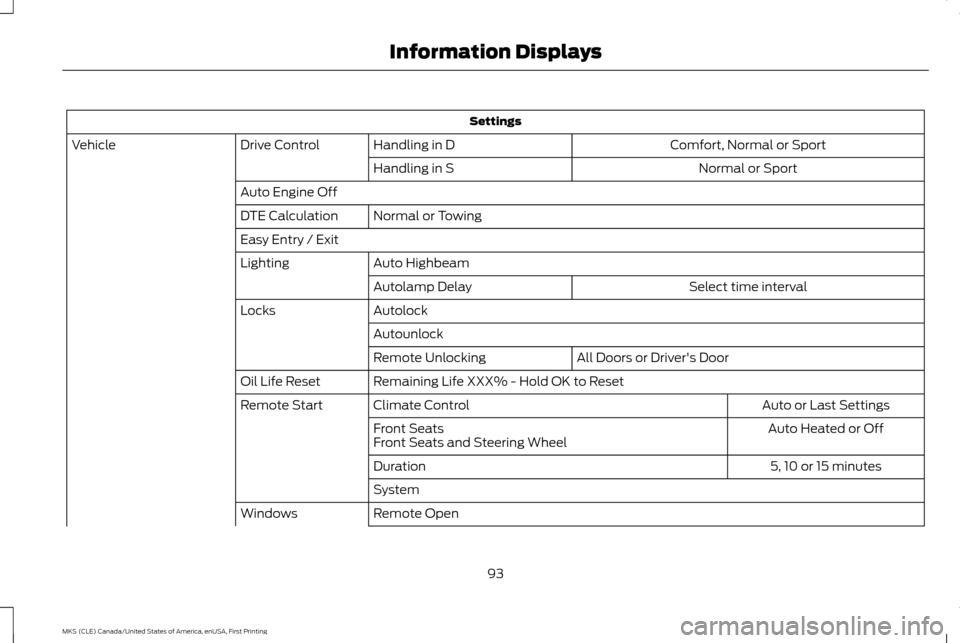
Settings
Comfort, Normal or Sport
Handling in D
Drive Control
Vehicle
Normal or Sport
Handling in S
Auto Engine Off Normal or Towing
DTE Calculation
Easy Entry / Exit
Auto Highbeam
Lighting
Select time interval
Autolamp Delay
Autolock
Locks
Autounlock All Doors or Driver's Door
Remote Unlocking
Remaining Life XXX% - Hold OK to Reset
Oil Life Reset
Auto or Last Settings
Climate Control
Remote Start
Auto Heated or Off
Front Seats
Front Seats and Steering Wheel
5, 10 or 15 minutes
Duration
System
Remote Open
Windows
93
MKS (CLE) Canada/United States of America, enUSA, First Printing Information Displays
Page 166 of 382
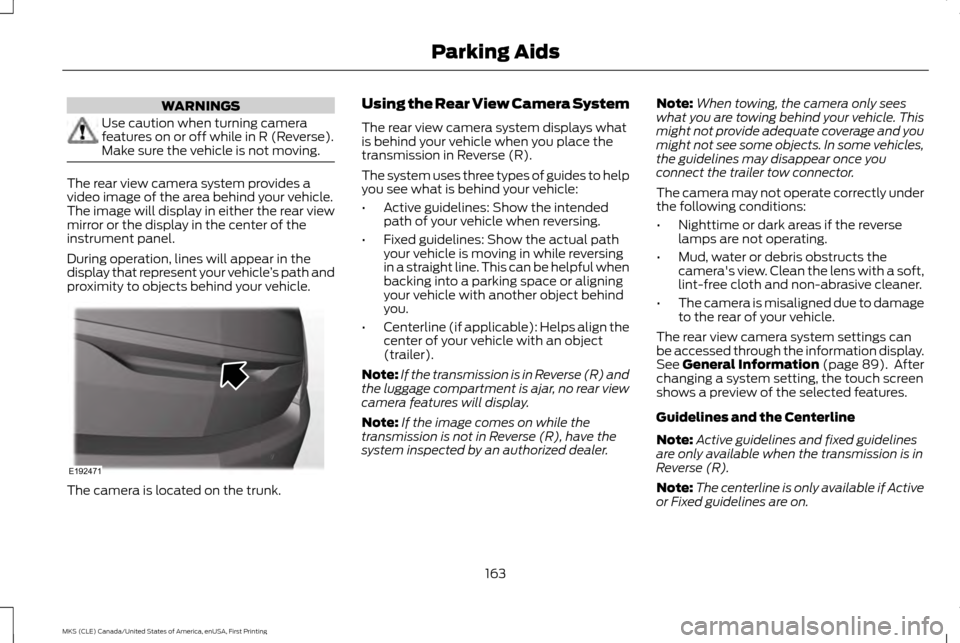
WARNINGS
Use caution when turning camera
features on or off while in R (Reverse).
Make sure the vehicle is not moving.
The rear view camera system provides a
video image of the area behind your vehicle.
The image will display in either the rear view
mirror or the display in the center of the
instrument panel.
During operation, lines will appear in the
display that represent your vehicle
’s path and
proximity to objects behind your vehicle. The camera is located on the trunk. Using the Rear View Camera System
The rear view camera system displays what
is behind your vehicle when you place the
transmission in Reverse (R).
The system uses three types of guides to help
you see what is behind your vehicle:
•
Active guidelines: Show the intended
path of your vehicle when reversing.
• Fixed guidelines: Show the actual path
your vehicle is moving in while reversing
in a straight line. This can be helpful when
backing into a parking space or aligning
your vehicle with another object behind
you.
• Centerline (if applicable): Helps align the
center of your vehicle with an object
(trailer).
Note: If the transmission is in Reverse (R) and
the luggage compartment is ajar, no rear view
camera features will display.
Note: If the image comes on while the
transmission is not in Reverse (R), have the
system inspected by an authorized dealer. Note:
When towing, the camera only sees
what you are towing behind your vehicle. This
might not provide adequate coverage and you
might not see some objects. In some vehicles,
the guidelines may disappear once you
connect the trailer tow connector.
The camera may not operate correctly under
the following conditions:
• Nighttime or dark areas if the reverse
lamps are not operating.
• Mud, water or debris obstructs the
camera's view. Clean the lens with a soft,
lint-free cloth and non-abrasive cleaner.
• The camera is misaligned due to damage
to the rear of your vehicle.
The rear view camera system settings can
be accessed through the information display.
See General Information (page 89). After
changing a system setting, the touch screen
shows a preview of the selected features.
Guidelines and the Centerline
Note: Active guidelines and fixed guidelines
are only available when the transmission is in
Reverse (R).
Note: The centerline is only available if Active
or Fixed guidelines are on.
163
MKS (CLE) Canada/United States of America, enUSA, First Printing Parking AidsE192471
Page 170 of 382

Switching Cruise Control Off
Press and release OFF when the system is
in stand by mode or switch the ignition off.
Note: You erase the set speed when you
switch the system off.
USING ADAPTIVE CRUISE
CONTROL
(If Equipped) WARNINGS
Always pay close attention to changing
road conditions when using adaptive
cruise control. The system does not
replace attentive driving. Failing to pay
attention to the road may result in a crash,
serious injury or death. Adaptive cruise control is not a crash
warning or avoidance system.
Adaptive cruise control will not detect
stationary or slow moving vehicles
below 6 mph (10 km/h).
Adaptive cruise control does not detect
pedestrians or objects in the road.
Adaptive cruise control does not detect
oncoming vehicles in the same lane. WARNINGS
Do not use the adaptive cruise control
when entering or leaving a highway, in
heavy traffic or on roads that are
winding, slippery or unpaved. Do not use the system in poor visibility,
for example fog, heavy rain, spray or
snow.
Do not use adaptive cruise control
when towing a trailer that has trailer
brakes. The auto-brake component of
the adaptive cruise control system does not
operate the trailer brakes. Using adaptive
cruise control when towing a trailer that has
trailer brakes may result in the loss of vehicle
control, which could result in serious injury. Do not use tire sizes other than those
recommended because this can affect
the normal operation of the system.
Failing to do so may result in a loss of vehicle
control, which could result in serious injury. Note:
It is your responsibility to stay alert, drive
safely and be in control of the vehicle at all
times.
The system adjusts your speed to maintain
a proper distance between you and the
vehicle in front of you in the same lane. You
can select from one of four gap settings. The adaptive cruise controls are on the
steering wheel.
Setting Adaptive Cruise Control
Press and release
ON.
The indicator appears in the
instrument cluster.
167
MKS (CLE) Canada/United States of America, enUSA, First Printing Cruise ControlE173593 E144529 E173594
Page 184 of 382
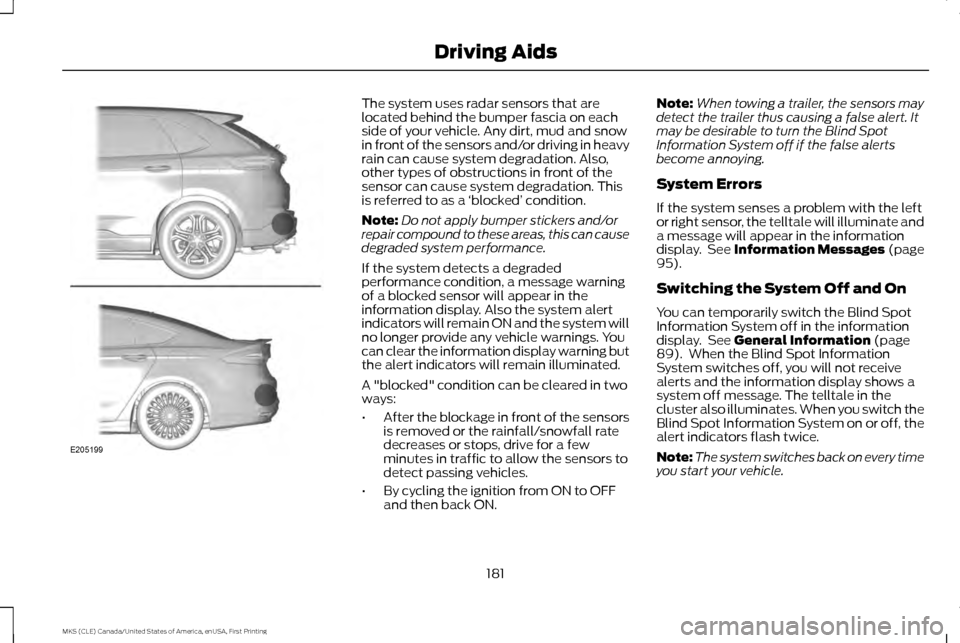
The system uses radar sensors that are
located behind the bumper fascia on each
side of your vehicle. Any dirt, mud and snow
in front of the sensors and/or driving in heavy
rain can cause system degradation. Also,
other types of obstructions in front of the
sensor can cause system degradation. This
is referred to as a
‘blocked ’ condition.
Note: Do not apply bumper stickers and/or
repair compound to these areas, this can cause
degraded system performance.
If the system detects a degraded
performance condition, a message warning
of a blocked sensor will appear in the
information display. Also the system alert
indicators will remain ON and the system will
no longer provide any vehicle warnings. You
can clear the information display warning but
the alert indicators will remain illuminated.
A "blocked" condition can be cleared in two
ways:
• After the blockage in front of the sensors
is removed or the rainfall/snowfall rate
decreases or stops, drive for a few
minutes in traffic to allow the sensors to
detect passing vehicles.
• By cycling the ignition from ON to OFF
and then back ON. Note:
When towing a trailer, the sensors may
detect the trailer thus causing a false alert. It
may be desirable to turn the Blind Spot
Information System off if the false alerts
become annoying.
System Errors
If the system senses a problem with the left
or right sensor, the telltale will illuminate and
a message will appear in the information
display. See Information Messages (page
95).
Switching the System Off and On
You can temporarily switch the Blind Spot
Information System off in the information
display. See
General Information (page
89). When the Blind Spot Information
System switches off, you will not receive
alerts and the information display shows a
system off message. The telltale in the
cluster also illuminates. When you switch the
Blind Spot Information System on or off, the
alert indicators flash twice.
Note: The system switches back on every time
you start your vehicle.
181
MKS (CLE) Canada/United States of America, enUSA, First Printing Driving AidsE205199
Page 189 of 382
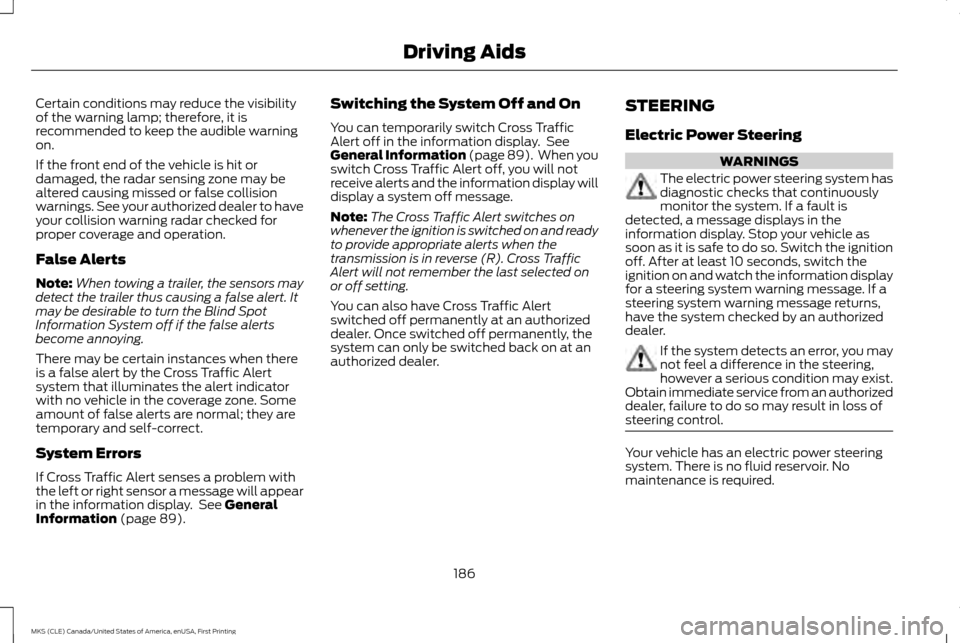
Certain conditions may reduce the visibility
of the warning lamp; therefore, it is
recommended to keep the audible warning
on.
If the front end of the vehicle is hit or
damaged, the radar sensing zone may be
altered causing missed or false collision
warnings. See your authorized dealer to have
your collision warning radar checked for
proper coverage and operation.
False Alerts
Note:
When towing a trailer, the sensors may
detect the trailer thus causing a false alert. It
may be desirable to turn the Blind Spot
Information System off if the false alerts
become annoying.
There may be certain instances when there
is a false alert by the Cross Traffic Alert
system that illuminates the alert indicator
with no vehicle in the coverage zone. Some
amount of false alerts are normal; they are
temporary and self-correct.
System Errors
If Cross Traffic Alert senses a problem with
the left or right sensor a message will appear
in the information display. See General
Information (page 89). Switching the System Off and On
You can temporarily switch Cross Traffic
Alert off in the information display. See
General Information
(page 89). When you
switch Cross Traffic Alert off, you will not
receive alerts and the information display will
display a system off message.
Note: The Cross Traffic Alert switches on
whenever the ignition is switched on and ready
to provide appropriate alerts when the
transmission is in reverse (R). Cross Traffic
Alert will not remember the last selected on
or off setting.
You can also have Cross Traffic Alert
switched off permanently at an authorized
dealer. Once switched off permanently, the
system can only be switched back on at an
authorized dealer. STEERING
Electric Power Steering WARNINGS
The electric power steering system has
diagnostic checks that continuously
monitor the system. If a fault is
detected, a message displays in the
information display. Stop your vehicle as
soon as it is safe to do so. Switch the ignition
off. After at least 10 seconds, switch the
ignition on and watch the information display
for a steering system warning message. If a
steering system warning message returns,
have the system checked by an authorized
dealer. If the system detects an error, you may
not feel a difference in the steering,
however a serious condition may exist.
Obtain immediate service from an authorized
dealer, failure to do so may result in loss of
steering control. Your vehicle has an electric power steering
system. There is no fluid reservoir. No
maintenance is required.
186
MKS (CLE) Canada/United States of America, enUSA, First Printing Driving Aids
Page 197 of 382
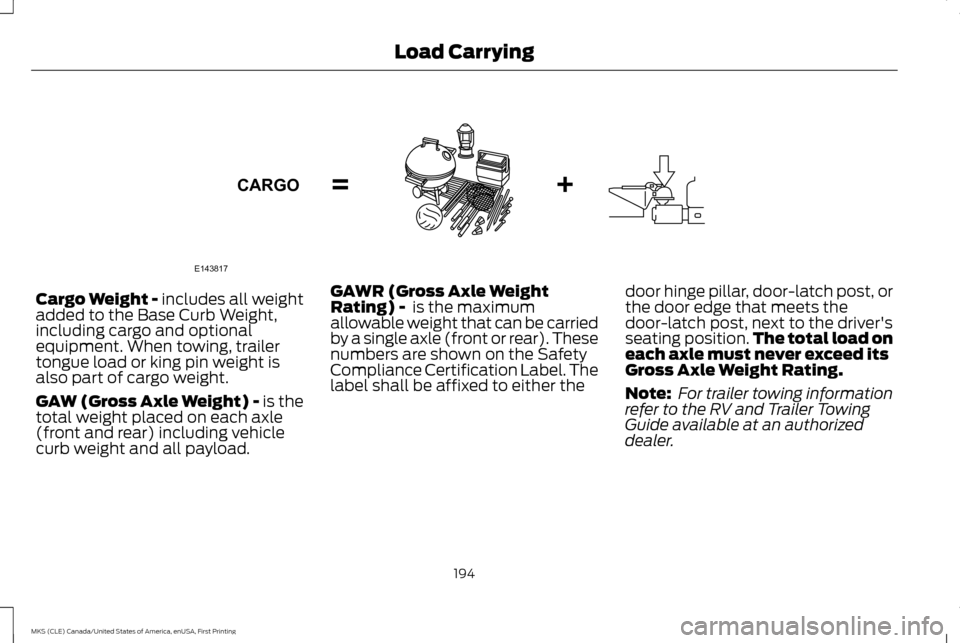
Cargo Weight - includes all weight
added to the Base Curb Weight,
including cargo and optional
equipment. When towing, trailer
tongue load or king pin weight is
also part of cargo weight.
GAW (Gross Axle Weight) - is the
total weight placed on each axle
(front and rear) including vehicle
curb weight and all payload.
GAWR (Gross Axle Weight
Rating) - is the maximum
allowable weight that can be carried
by a single axle (front or rear). These
numbers are shown on the Safety
Compliance Certification Label. The
label shall be affixed to either the door hinge pillar, door-latch post, or
the door edge that meets the
door-latch post, next to the driver's
seating position.
The total load on
each axle must never exceed its
Gross Axle Weight Rating.
Note: For trailer towing information
refer to the RV and Trailer Towing
Guide available at an authorized
dealer.
194
MKS (CLE) Canada/United States of America, enUSA, First Printing Load CarryingE143817CARGO
Page 200 of 382
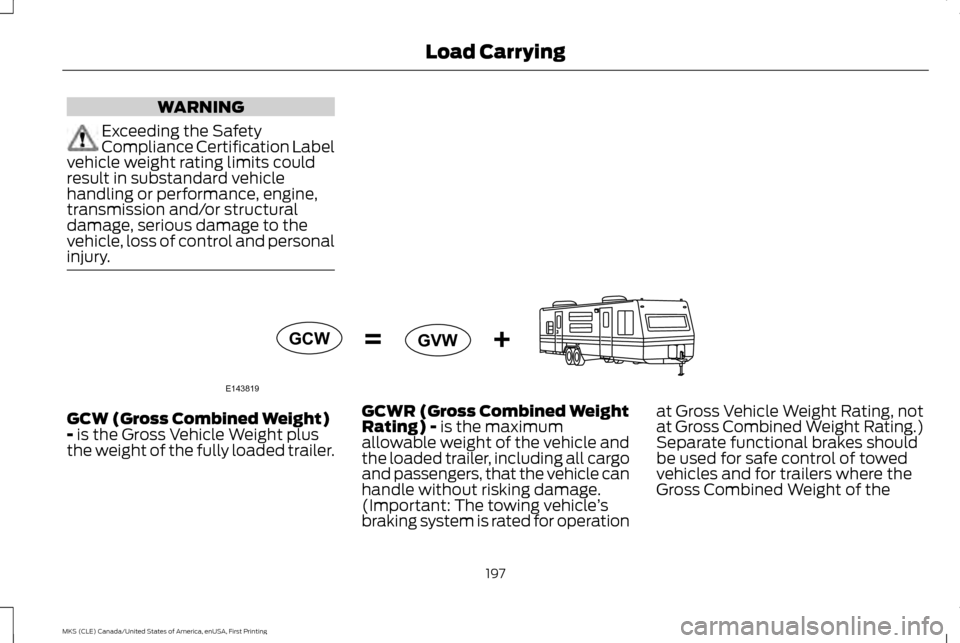
WARNING
Exceeding the Safety
Compliance Certification Label
vehicle weight rating limits could
result in substandard vehicle
handling or performance, engine,
transmission and/or structural
damage, serious damage to the
vehicle, loss of control and personal
injury. GCW (Gross Combined Weight)
- is the Gross Vehicle Weight plus
the weight of the fully loaded trailer. GCWR (Gross Combined Weight
Rating) - is the maximum
allowable weight of the vehicle and
the loaded trailer, including all cargo
and passengers, that the vehicle can
handle without risking damage.
(Important: The towing vehicle ’s
braking system is rated for operation at Gross Vehicle Weight Rating, not
at Gross Combined Weight Rating.)
Separate functional brakes should
be used for safe control of towed
vehicles and for trailers where the
Gross Combined Weight of the
197
MKS (CLE) Canada/United States of America, enUSA, First Printing Load CarryingE143819GCW
GVW
Page 201 of 382
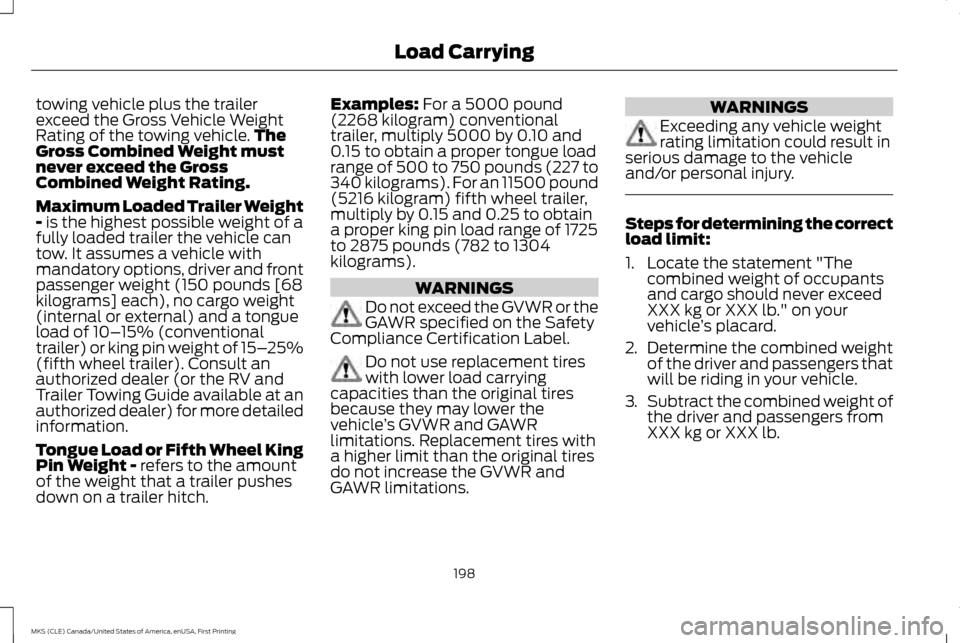
towing vehicle plus the trailer
exceed the Gross Vehicle Weight
Rating of the towing vehicle.
The
Gross Combined Weight must
never exceed the Gross
Combined Weight Rating.
Maximum Loaded Trailer Weight
- is the highest possible weight of a
fully loaded trailer the vehicle can
tow. It assumes a vehicle with
mandatory options, driver and front
passenger weight (150 pounds [68
kilograms] each), no cargo weight
(internal or external) and a tongue
load of 10– 15% (conventional
trailer) or king pin weight of 15– 25%
(fifth wheel trailer). Consult an
authorized dealer (or the RV and
Trailer Towing Guide available at an
authorized dealer) for more detailed
information.
Tongue Load or Fifth Wheel King
Pin Weight -
refers to the amount
of the weight that a trailer pushes
down on a trailer hitch. Examples:
For a 5000 pound
(2268 kilogram) conventional
trailer, multiply 5000 by 0.10 and
0.15 to obtain a proper tongue load
range of 500 to 750 pounds (227 to
340 kilograms). For an 11500 pound
(5216 kilogram) fifth wheel trailer,
multiply by 0.15 and 0.25 to obtain
a proper king pin load range of 1725
to 2875 pounds (782 to 1304
kilograms). WARNINGS
Do not exceed the GVWR or the
GAWR specified on the Safety
Compliance Certification Label. Do not use replacement tires
with lower load carrying
capacities than the original tires
because they may lower the
vehicle ’s GVWR and GAWR
limitations. Replacement tires with
a higher limit than the original tires
do not increase the GVWR and
GAWR limitations. WARNINGS
Exceeding any vehicle weight
rating limitation could result in
serious damage to the vehicle
and/or personal injury. Steps for determining the correct
load limit:
1. Locate the statement "The
combined weight of occupants
and cargo should never exceed
XXX kg or XXX lb." on your
vehicle ’s placard.
2. Determine the combined weight
of the driver and passengers that
will be riding in your vehicle.
3. Subtract the combined weight of
the driver and passengers from
XXX kg or XXX lb.
198
MKS (CLE) Canada/United States of America, enUSA, First Printing Load Carrying
Page 202 of 382
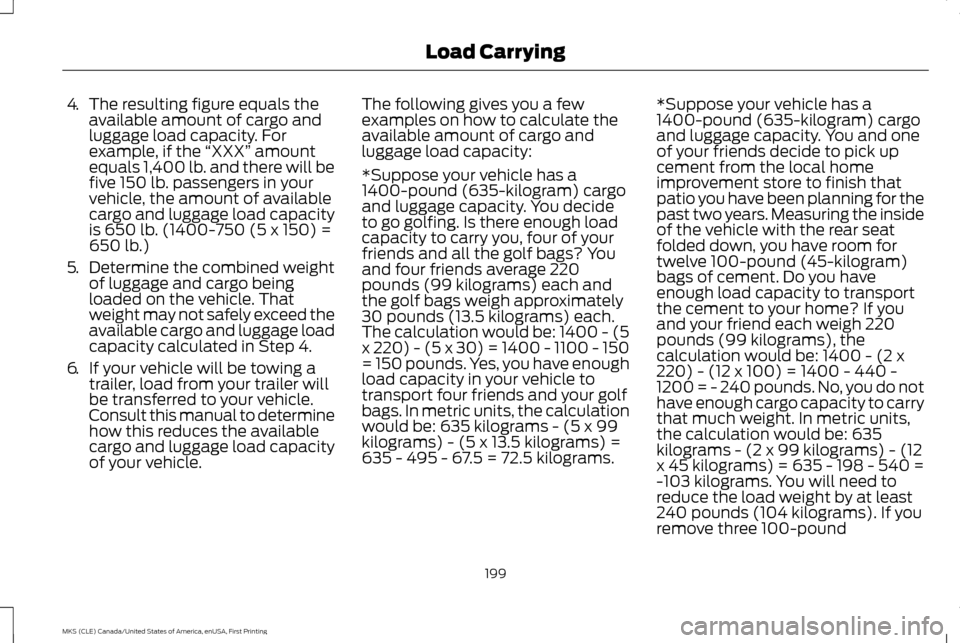
4.
The resulting figure equals the
available amount of cargo and
luggage load capacity. For
example, if the “XXX” amount
equals 1,400 lb. and there will be
five 150 lb. passengers in your
vehicle, the amount of available
cargo and luggage load capacity
is 650 lb. (1400-750 (5 x 150) =
650 lb.)
5. Determine the combined weight
of luggage and cargo being
loaded on the vehicle. That
weight may not safely exceed the
available cargo and luggage load
capacity calculated in Step 4.
6. If your vehicle will be towing a
trailer, load from your trailer will
be transferred to your vehicle.
Consult this manual to determine
how this reduces the available
cargo and luggage load capacity
of your vehicle. The following gives you a few
examples on how to calculate the
available amount of cargo and
luggage load capacity:
*Suppose your vehicle has a
1400-pound (635-kilogram) cargo
and luggage capacity. You decide
to go golfing. Is there enough load
capacity to carry you, four of your
friends and all the golf bags? You
and four friends average 220
pounds (99 kilograms) each and
the golf bags weigh approximately
30 pounds (13.5 kilograms) each.
The calculation would be: 1400 - (5
x 220) - (5 x 30) = 1400 - 1100 - 150
= 150 pounds. Yes, you have enough
load capacity in your vehicle to
transport four friends and your golf
bags. In metric units, the calculation
would be: 635 kilograms - (5 x 99
kilograms) - (5 x 13.5 kilograms) =
635 - 495 - 67.5 = 72.5 kilograms.
*Suppose your vehicle has a
1400-pound (635-kilogram) cargo
and luggage capacity. You and one
of your friends decide to pick up
cement from the local home
improvement store to finish that
patio you have been planning for the
past two years. Measuring the inside
of the vehicle with the rear seat
folded down, you have room for
twelve 100-pound (45-kilogram)
bags of cement. Do you have
enough load capacity to transport
the cement to your home? If you
and your friend each weigh 220
pounds (99 kilograms), the
calculation would be: 1400 - (2 x
220) - (12 x 100) = 1400 - 440 -
1200 = - 240 pounds. No, you do not
have enough cargo capacity to carry
that much weight. In metric units,
the calculation would be: 635
kilograms - (2 x 99 kilograms) - (12
x 45 kilograms) = 635 - 198 - 540 =
-103 kilograms. You will need to
reduce the load weight by at least
240 pounds (104 kilograms). If you
remove three 100-pound
199
MKS (CLE) Canada/United States of America, enUSA, First Printing Load Carrying